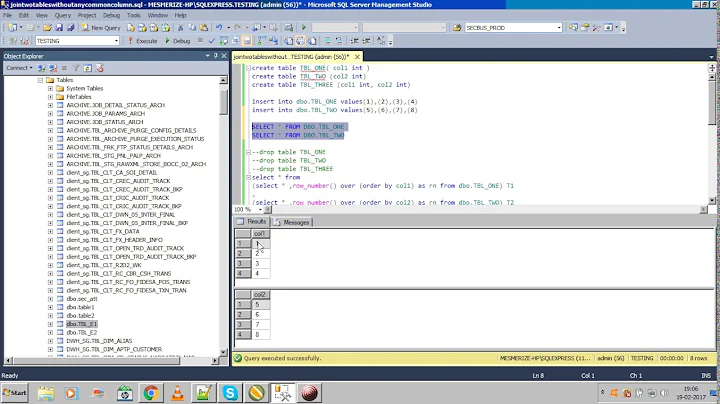How do I merge two tables without naming all columns?
Solution 1
I believe the only option you have to avoid using the column names is two separate statements:
delete from USER_COUNTERPARTY UC
where exists
(select null
from TEMP T
where T.COUNTER_ID = UC.COUNTER_ID);
insert into USER_COUNTERPARTY UC
select *
from TEMP T
where not exists
(select null
from USER_COUNTERPARTY UC
where T.COUNTER_ID = UC.COUNTER_ID);
Solution 2
I have come across the problem described and the way I have tackled it is very low tech, but thought I would share in case it triggered other ideas for people.
I took the column names (I extract them from the table DDL in SQL developer, but also use the method in the tab_columns table) and inserted them into an Excel spreadsheet. I then removed the Varchar etc statements (using text to columns Excel function and then just deleting the column(s) that the varchar, number etc statements ended up in) so it just left the field names. I then inserted a formula in the next Excel column, ="dest."&A2&"=src."&A2&"," and filled down for all 110 fields, and then in a new Excel column, used =A2&"," and in a new column, ="src."&A2&",", again filling down for all fields. Then in a SQL sheet, I enter:
merge into <schema>.<destination_table> dest
using <schema>.<source_table> src
on (dest.<link> = src.<link>)
when matched then update set
(<copy all of the first column,
not including the linking fields and removing the comma at the end>)
when not matched then insert
(<copy and paste the second column from Excel, and remove the final comma>)
values
(<copy and paste the third column from Excel and remove the final comma>)
I also have a version for merging tables with different column names, but that involves an additional step of mapping the fields in the Excel sheet.
I find I need to use merge statements for what I do - I find Merge into an immense time saver compared with Update where exists.
Solution 3
You could try using a wrapped union statement like this:
SELECT (*) FROM
(SELECT * FROM Table1 WHERE ID NOT IN (SELECT ID FROM Table2)
UNION ALL
SELECT * FROM Table2)
ORDER BY 1
Related videos on Youtube
jalopezp
Updated on June 04, 2022Comments
-
jalopezp almost 2 years
So say I have these two tables with the same columns. Use your imagination to make them bigger:
USER_COUNTERPARTY: ID |Name |Credit Rating |Sovereign Risk |Invoicing Type ----+----------------------------+-----------------+------------------+--------------- 1 |Nat Bank of Transnistria |7 |93 |Automatic 2 |Acme Ltd. |25 |12 |Automatic 3 |CowBInd LLP. |49 |12 |Manual TEMP: ID |Name |Credit Rating |Sovereign Risk |Invoicing Type ----+----------------------------+-----------------+------------------+--------------- 2 |Acacacme Ltd. |31 |12 |Manual 4 |Disenthralled Nimrod Corp. |31 |52 |Automaticand I want to merge them into one, replacing with the second one whatever has the same ID in the first one, and inserting whatever is not there. I can use this statement:
MERGE INTO USER_COUNTERPARTY C USING TEMP T ON (C.COUNTER_ID = T.COUNTER_ID) WHEN MATCHED THEN UPDATE SET C.COUNTER_NAME = T.COUNTER_NAME, C.COUNTER_CREDIT = T.COUNTER_CREDIT, C.COUNTER_SVRN_RISK = T.COUNTER_SVRN_RISK, C.COUNTER_INVOICE_TYPE = T.COUNTER_INVOICE_TYPE WHEN NOT MATCHED THEN INSERT VALUES ( T.COUNTER_ID, T.COUNTER_NAME, T.COUNTER_CREDIT, T.COUNTER_SVRN_RISK, T.COUNTER_INVOICE_TYPE);Which is nice enough, but notice that I have to name each of the columns. Is there any way to merge these tables without having to name all the columns? Oracle documentation insists that I use column names after both 'insert' and 'set' in a merger, so some other statement might be needed. The result should be this:
ID |Name |Credit Rating |Sovereign Risk |Invoicing Type ----+----------------------------+-----------------+------------------+--------------- 1 |Nat Bank of Transnistria |7 |93 |Automatic 2 |Acacacme Ltd. |31 |12 |Manual 3 |CowBInd LLP. |49 |12 |Manual 4 |Disenthralled Nimrod Corp. |31 |52 |AutomaticIn case it helps I'm pasting this here:
CREATE TABLE USER_COUNTERPARTY ( COUNTER_ID INTEGER NOT NULL PRIMARY KEY, COUNTER_NAME VARCHAR(38), COUNTER_CREDIT INTEGER, COUNTER_SVRN_RISK INTEGER, COUNTER_INVOICE_TYPE VARCHAR(10) ); INSERT ALL INTO USER_COUNTERPARTY VALUES (1, ‘Nat Bank of Transnistria’, 7, 93, ‘Automatic’) INTO USER_COUNTERPARTY VALUES (2, ‘Acme Ltd.’, 25, 12, ‘Manual’) INTO USER_COUNTERPARTY VALUES (3, ‘CowBInd LLP.’, 49, 12, ‘Manual’) SELECT * FROM DUAL; CREATE TABLE TEMP AS SELECT * FROM USER_COUNTERPARTY; DELETE FROM TEMP; INSERT ALL INTO TEMP VALUES (2, ‘Conoco Ltd.’, 25, 12, ‘Automatic’) INTO TEMP VALUES (4, ‘Disenthralled Nimrod Corp.’, 63, 12, ‘Manual’) SELECT * FROM DUAL; -
jalopezp about 12 yearsYeah, I guess this is the way to do it.
-
jalopezp about 12 yearsBut how come you use 'select null' instead of a 'select *'? Is this for efficiency? Should I also be doing this?
-
John Doyle about 12 yearsThe
selectin the sub-query to anexistsis just there to indicate if a row is returned or not, it doesn't matter what columns are returned. Some people will useselect 1, othersselect *, there is no real difference. -
RyanfaeScotland about 9 years@JohnDoyle I think your syntax is wrong for the table aliases. For me the first query needed changed to 'delete UC from USER_COUNTERPARTY UC' as per stackoverflow.com/questions/11005209/… and the second needed the alias removed on the first line which made it 'insert into USER_COUNTERPARTY'.
-
 D. Mika over 5 yearsOne big difference, which has to be considered, is the fact, that with the DELETE statement possibly existing ON DELETE CASCADE constraints cause the dependent tables may "lose" data records. This does not happen with MERGE.
D. Mika over 5 yearsOne big difference, which has to be considered, is the fact, that with the DELETE statement possibly existing ON DELETE CASCADE constraints cause the dependent tables may "lose" data records. This does not happen with MERGE.







